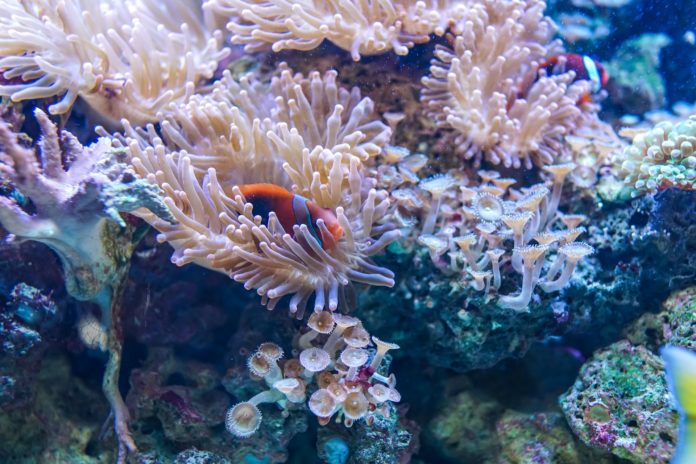For years, marine biologists have wondered how coral reefs are able to thrive in the midst of the barren, nutrient-poor plains that surround them. Now, new research from Simon Fraser University suggests the answer may lie in the fact that there are always plenty of fish in the sea.
The study was led by Simon Brandl, a Banting postdoctoral fellow in the Earth2Ocean group at Simon Fraser University, and published in Science.
A new solution to “Darwin’s Paradox”
While brightly-coloured fish and dazzling plant life may be the first thing that comes to mind when you think of tropical oceans, the reality is much more desolate than you’d expect. Large swathes of the world’s oceans are essentially devoid of nutrients, and in these conditions signs of life should be few and far in between.
Surprisingly, these so-called “oligotrophic” regions are exactly where most coral reefs are found. This apparent contradiction has been puzzling scientists since the 1800s — in fact, English naturalist Charles Darwin’s publications on the problem led to present-day marine biologists referring to it as “Darwin’s Paradox”.
To get a better understanding of what might be going on, Brandl and his colleagues decided to turn to the smallest fish species found in the reefs. These minuscule “cryptobenthic” fish species spend their time hiding in crevices, and often end up overlooked as a result. But after searching through decades of archival data and noticing how dominant these species really were, Brandl started to realize that there might be more to these tiniest members of the coral reef populations than he’d previously thought.
Like fish in a candy store
The secret behind this hidden food source is that cryptobenthic fish are really good at one thing in particular: dying.
These fish have a mortality rate of about 70%, and almost all of this goes towards feeding larger species on the reef. But where they’re extremely good at dying, cryptobenthic fish are equally as good at reproducing and replenishing their populations. Nearly all of the baby fish found in the waters near coral reefs are cryptobenthic species, and entire generations of these species can pass by in a matter of weeks.
“It’s essentially a bag of candy that magically replenishes every morsel eaten,” Brandl explained.
Yet while this bag of candy supplies essentially almost all the food in the coral reef, scientists rarely ever see it, because the fish get eaten faster than scientists can count them. It’s for this reason that they’ve gone unnoticed for so long.
Another key reason why cryptobenthic fish are able to provide so much of the food supply in coral reefs is also what sets them apart from other tiny marine species: while most fish leave their birthplaces and travel off into the dangerous unknown of the open oceans, cryptobenthic species never stray too far from home. By avoiding the “death trap” that is the open ocean, “these fish get a lot more bang for their buck with every egg they spawn,” according to Brandl.
To determine how important these fish are, Brandl and his team also ran simulations of the daily arrival, growth, and death of cryptobenthic larvae, which they compared against the number of adult fish they were able to capture and count. This allowed them to get a grasp on just how much of the total consumed fish biomass these species account for — 60% of all fish eaten on the reef, to be exact.
“They are tiny, [colourful] bundles of energy that get eaten almost immediately by any coral reef organism that can bite, grab, or slurp them up,” Brandl said.
The “dark productivity” of the ocean
Cryptobenthic fish likely aren’t the only explanation behind Darwin’s Paradox, but they’re an important piece of the puzzle, and undoubtedly contribute a large fraction of what Brandl and his team call the “dark productivity” of coral reefs.
“[Cryptobenthic fish] are another one of these quirks of coral reefs that probably help them be these wonderful oases of life in mostly food-deprived waters,” Brandl told Nexus Media.
But Brandl and his team worry that these tiny fish — and the dazzling ocean oases that they underpin — are at risk. The most complex coral reefs may be the most strongly affected by rising ocean temperatures, which would leave cryptobenthic fish without all the nooks, crevices, and crannies they usually call home. This would mean declining populations of this crucial food source.
Brandl and his colleagues hope that their research will help guide future conservation efforts. By focusing preservation strategies on cryptobenthic species, conservationists may have a better chance of preserving the coral reef as a whole.









































